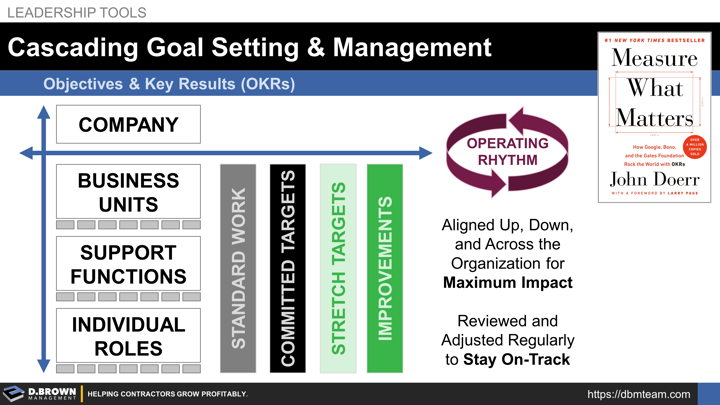What are our broad aspirations for our organization and the concrete goals against which we can measure our progress?
This is the first of the five interlinked questions that define strategy.
Starting at the very top level of the company, these goals must be broken down within each part of the business. See The Contractor Business Model and your own Organizational Chart to visualize all elements of the business.
Consider breaking your goals down into four broad categories:
- Standard Work: These are the routine habits that will most likely lead to the expected outcomes. Standard work defines both how and when things get done. This is the foundation of any job role or team and is the best method for achieving consistently good results.
- Committed Targets: These are the outcome expectations that your business model, plans, and basic incentive compensation programs are built around. Accountabilities by role are built around these.
- Stretch Targets: These may be 20–50% or more above the committed targets, based on some lower-probability factors. They are used to drive innovation and inspiration. There is an upside to hitting these without any downside.
- Improvements: These are over and above standard work and have a lot to do with success in achieving the stretch targets.
Every person and team in the organization should have goals in at least the first two categories. In the field, this may be standard installation methods for different units of work, such as standard production rates. Job Role Descriptions should incorporate most of the standard items. Stretch goals and improvements are typically added in as part of the regular planning process.
Whether the system you use is Objectives and Key Results (OKRs), 4-Disciplines of Execution (4DX), or Rocks and Metrics from Entrepreneurial Operating System (EOS), the basic principles and challenges are the same.
Regardless of the tool, the biggest execution variables are:
- Creativity of the team in aligning goals.
- Ability of the team to think in terms of “Prioritized Outcomes” rather than “Things to Do”
- The discipline to continually “Force-Rank” priorities until the organization is just down to a few true priorities.
- The discipline of routine execution even as the process runs into challenges during the first few cycles.
An experienced and unbiased 3rd party can help your team find the best tools for where they are at, clearly define the goals, ensure integration, align the team, and keep pressure on your vision. Please contact us to learn about our wide range of experiences with different systems and teams.
LEARN MORE
Cascading Metrics Integrated with Org Structure - Cash Flow Example
Key Results and Leading Activities (Standard Work) Example
Google's OKR Playbook (From Book Website)

